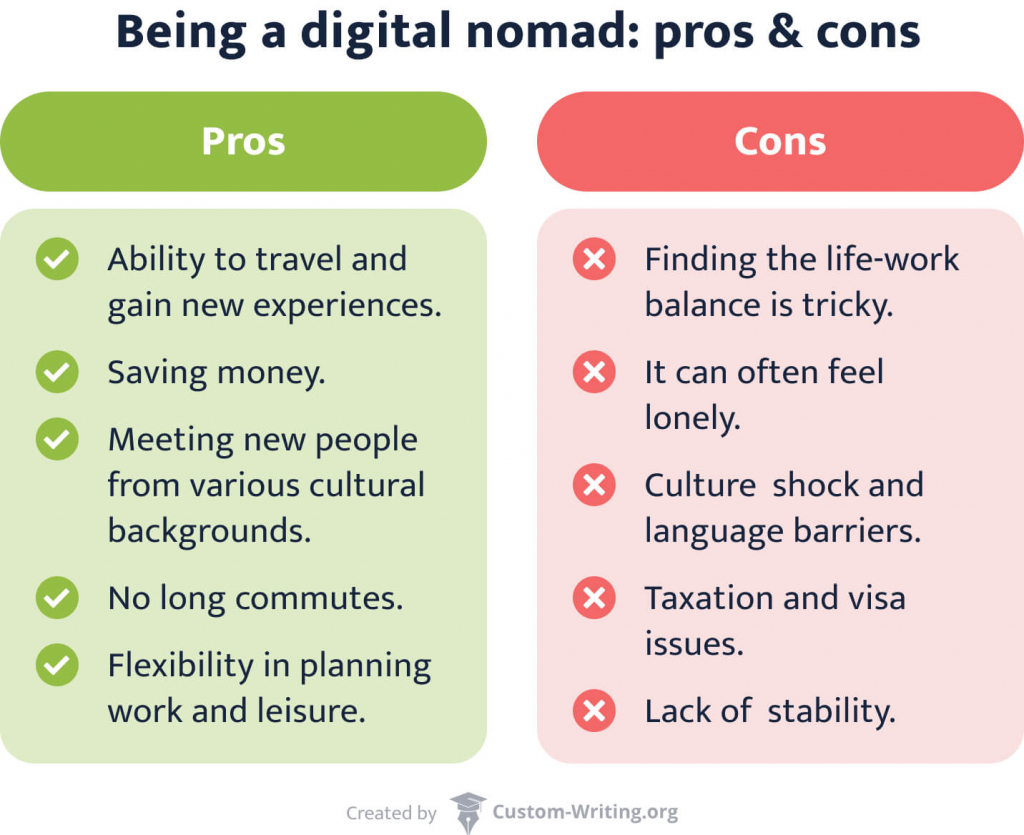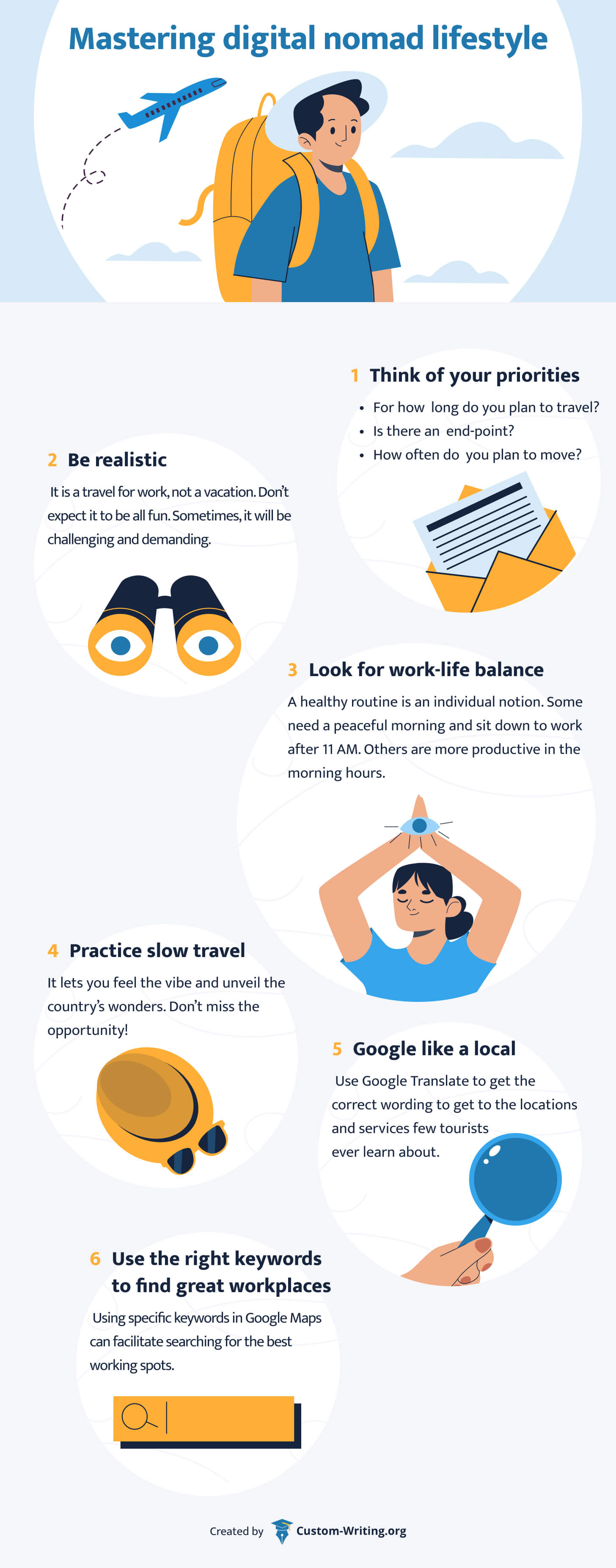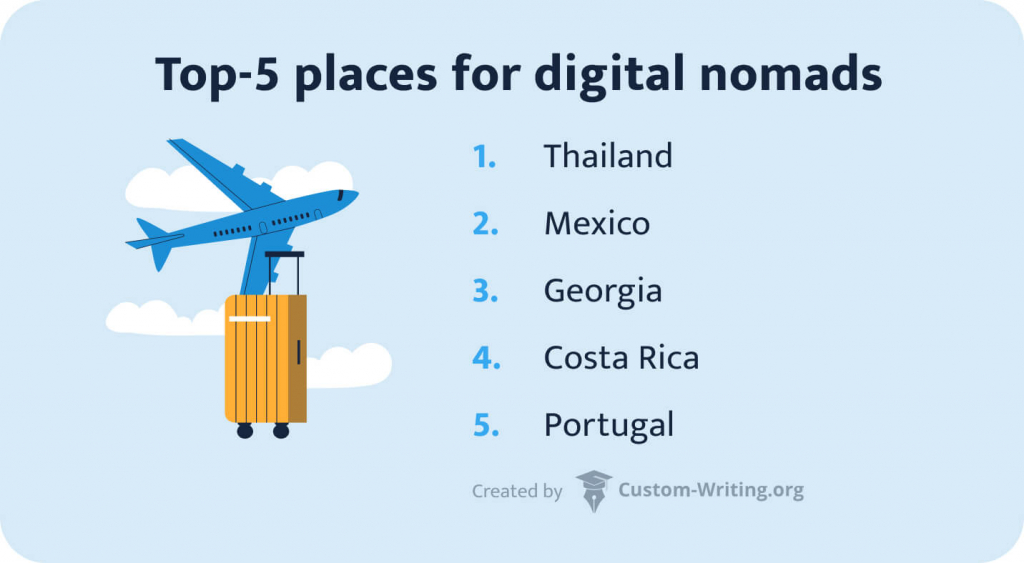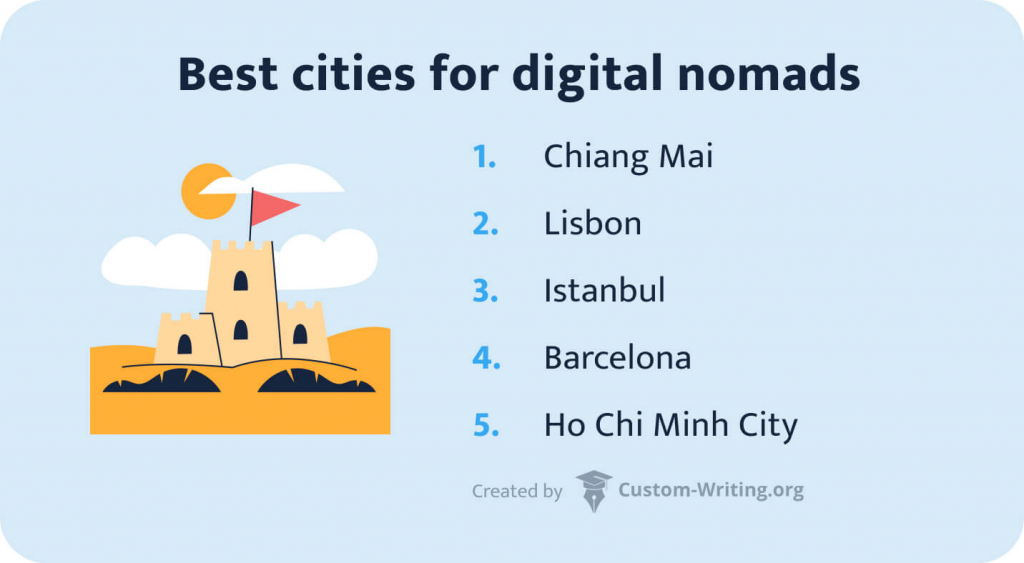About 40 million people worldwide are now digital nomads, representing 1.18% of the 3.4 billion people employed, and the trend is on the rise. Out of 131.8 million employees in the US, there are 17.3 million digital nomads, making up 13.13%.
Surprisingly, 40% of them are over 40 years old, and 24% have children.
People of any age and family composition choose digital nomadism.
But:
- How exactly do digital nomads make money?
- What makes them cosmopolitans?
- Is embracing such a lifestyle worth it?
Curious? Let’s dive into the details!
🔢 Digital Nomad Essentials
A digital nomad is someone whose job allows them to travel for leisure while fulfilling their professional obligations. A remote job with a good salary, coupled with a passion for exploration, are digital nomad essentials.

Contrasting this notion with two similar but distinct concepts provides clarity.
Digital Nomad Vs. Remote Worker
A digital nomad, while also a remote worker, moves from place to place, typically staying for only a few months.
Meanwhile:
The majority of remote workers adopt a stationary lifestyle, working from the comfort of their homes, rarely visiting the office, if at all.
Remote work often serves as a viable option for individuals with disabilities or parents who care for young children. Should they choose to adopt a nomadic lifestyle, they could transition from remote workers to digital nomads. Until then, they remain remote workers, not digital nomads.
In summary, while remote worker is a broad term, digital nomad represents a more specific lifestyle.
Digital Nomad Vs. Expat
While an expat relocates to another country with intentions to establish roots there, digital nomads have a different approach. They embrace a lifestyle of constant travel rather than settling down permanently. Digital nomads prioritize mobility and flexibility, often working remotely while exploring various destinations.
💸 6 Ways to Make Money as a Digital Nomad
Not every job is suitable for the digital nomad lifestyle.
Here’s a checklist for an ideal digital nomad job:
- Fully flexible working hours, regardless of the time zone.
- No restrictions on geographic location.
- Ability to work with an unstable internet connection, as digital nomads often work from coworking spaces and cafes.

Below are some of the best jobs for digital nomads, all meeting these criteria.
Virtual Assistant
CEOs and top-level managers often have overwhelming tasks that they struggle to manage alone. While some prefer in-house personal assistants, a virtual assistant provides remote support. They handle research, data organization, customer interactions, and administrative tasks from afar.
Skills and Qualifications
- Excellent soft skills in client and staff interaction.
- Basic computer proficiency (Microsoft Office, online calendars, and desktop sharing).
- Strong time management and multitasking abilities.
- Capacity to work independently with minimal supervision.
Pros and Cons
Approximate Salary
According to Upwork, the salaries begin at $12 per hour, varying based on task complexity.
Web Developer
Working alongside graphic designers and programmers, web developers are responsible for creating websites. They then monitor their functionality and optimize pages accordingly, ensuring they display well across all platforms, including mobile and desktop. Some web developers also possess coding and scripting skills for applications.
Skills and Qualifications
- Proficiency in HTML and CSS.
- Knowledge of JavaScript.
- Familiarity with content management systems (CMS) such as WordPress and Joomla.
- Understanding of search engine optimization (SEO) practices.
Pros and Cons
Approximate Salary
According to Upwork, web developers earn approximately $15 per hour for simpler websites and $30 for more sophisticated pages.
Programmer
Programmers are responsible for creating the software used on your PC or mobile devices. They are highly sought-after professionals and often command some of the highest salaries in the job market.
Skills and Qualifications
- Proficiency in one or several programming languages, such as Java, Python, C++, and Ruby.
- Ability to strictly adhere to deadlines and technical requirements.
- Collaboration skills to work effectively in teams with other programmers and project managers.
Pros and Cons
Approximate Salary
The average salary of an entry-level programmer in the US in 2024 ranges between $36 and $46 per hour.
Freelance Writer
Freelance writers are professionals who create blog posts, articles, social media content, and other web-based materials on a project basis. Much of the content you encounter online is written by freelance writers.
Skills and Qualifications
- Excellent writing skills.
- Strong understanding of grammar.
- Ability to adapt your writing style to the client’s needs.
Pros and Cons
Approximate Salary
According to Upwork, freelance writers can earn anywhere from $15 to $40 per hour.
Graphic Designer
Graphic designers are responsible for creating visual content, both digital and printed. This includes designing logos, advertisements, posters, website banners, and product packaging. They translate abstract concepts into tangible designs, serving as the physical representation of a brand.
Skills and Qualifications
- A diploma in Art or Graphic Design.
- Proficiency in image-editing software, such as Adobe Photoshop, Illustrator, InDesign, Corel Draw, and Figma.
- A diverse portfolio showcasing previous work
- Ability to adapt to different artistic styles and meet task requirements.
Pros and Cons
Approximate Salary
Upwork estimates the average salary of graphic designers to be between $15 and $35 per hour.
Vlogger
Vlogging stands out as one of the best nomad jobs for individuals with no prior experience. Vloggers create engaging, educational, entertaining, or informative videos for platforms like YouTube, TikTok, Instagram, or Facebook, catering to their followers’ interests while establishing an online presence.
Skills and Qualifications
- Proficiency in storytelling to captivate audiences.
- Passion for public speaking and engaging with viewers.
- An exciting topic or idea to explore and develop content around.
Pros and Cons
Approximate Salary
Vloggers primarily earn income through embedded advertisements, sponsored content, brand partnerships, and donations on platforms like Patreon. Earnings depend significantly on the size of their subscriber base.
While we’ve highlighted some of the best digital nomad jobs, the opportunities extend far beyond this list. From online medical consultants to personal coaches and psychotherapists, nearly every profession has a remote variant.
However, some professions, like plumbing, still require primarily offline presence. With each passing year, new remote professions emerge, adding to the list.
⚖️ Being a Digital Nomad: Pros & Cons
The lifestyle of a digital nomad is not suited for everyone. Let’s consider the primary pros and cons of adopting such an approach to work and living, helping you determine if it is the right option for you.

5 Pros of Being a Digital Nomad
- Ability to travel and gain new experiences. Many people regret not traveling more when reflecting on their lives. Being a digital nomad allows you to blend work and travel, enabling you to explore new places while earning a living.
- Surprising savings. Moving between countries while earning money can actually help you save. Living in countries like Thailand, known for their affordability, while working for a company based in a high-cost location like New York can lead to significant savings.
- Meeting interesting people from diverse cultural backgrounds. Interacting with people from different cultures enriches your life and broadens your perspective. These interactions expose you to new ways of thinking and living, fostering personal growth and development.
- No long commutes. In urban areas, commuting to and from work can consume a significant amount of time and energy. By working remotely as a digital nomad, you can avoid lengthy commutes, save time, and improve your overall well-being.
- Complete flexibility in work and leisure planning. Traditional office hours may not align with everyone’s natural rhythms and energy levels. As a digital nomad, you have the freedom to structure your workday according to your preferences, optimizing productivity and allowing for a better work-life balance.
5 Cons of Being a Digital Nomad
- Tricky work-life balance. Unlike office workers who have clear distinctions between workdays and days off, remote workers often blur these boundaries. Being paid per hour can intensify overworking, leading to a constant struggle to find the balance between work, domestic responsibilities, and social life.
- Loneliness. Constantly moving from place to place can lead to feelings of loneliness, especially if you lack a consistent support system. Relationships tend to lack depth due to the transient nature of digital nomad life, making it essential to seek companionship within the digital nomad community.
- Culture shock and language barriers. Adapting to new cultures and communities can be more challenging than anticipated, compounded by language barriers that complicate meaningful connections. Over time, the superficiality of small talk becomes tiresome, leaving digital nomads craving deeper interactions.
- Tax issues. Many countries impose strict regulations on individuals earning money within their borders, requiring working visas or additional taxes. Navigating these legal complexities demands sound legal advice with each cross-border move, adding a layer of administrative burden to the nomadic lifestyle.
- Lack of stability. Freelance work inherently lacks stability, with fluctuating client demands leading to unpredictable income streams. Establishing an emergency fund becomes essential to weather periods of financial uncertainty.
🧭 How to Become a Digital Nomad: 11 Steps
If the pros have sounded attractive, and the cons haven’t dissuaded you, let’s move on to the next stage:
Learning how to become and prosper as a digital nomad in 11 steps.

Step 1: Identify if Such a Lifestyle Suits You
Consider the implications of the pros and cons above.
Here are some hard questions to ponder:
- Am I ready for the lack of stability in salary, level of life, and relationships?
- Can I lead a minimalistic lifestyle with a suitcase of personal belongings?
- How much will I miss my relatives and friends?
- Am I comfortable with the vulnerability to scams and criminals while traveling, along with the frequent jet lag that may undermine my health and productivity?
- Can I establish a viable work-life balance?
Step 2: Evaluate Your Skills & Character Traits
Digital nomadism requires specific skills, knowledge, and character traits. If you are still acquiring them, consider the activities that bring the most inspiration and joy. Remote work encompasses various fields: writing, language assistance, programming, technical support, and more.
We recommend taking this test as a starting point. It is trendy, fun, and free.
Step 3: Strengthen Your Skills
Continuous learning is essential in most professions, but some foundational knowledge is necessary before you begin.
The good news is:
Learning today is easier than it used to be, even just a few years ago. Many top-level universities offer remote courses, and some are even free.
One of the easiest options is Coursera, which offers hundreds of courses. Upon completion, you will receive an official certificate that is accepted by most employers.
For example, aspiring programmers may find these Python courses interesting.
Another option is to explore the websites of the universities you prefer.
For instance:
Marketing and accounting courses at Harvard Business School would be an excellent choice for a digital nomad. Courses in entrepreneurship and strategy could be beneficial for those aiming to grow their business, such as an online shop or a specific product.
While high-quality courses with approved certificates can be expensive, they are often far less costly than full-time education at a prestigious university.
Step 4: Consider Your Destinations
Your future destinations will impact your budget. Before purchasing your ticket, carefully consider your itinerary.
Use this digital nomad checklist:
- Is the natural environment attractive and conducive to staying?
- Does the culture appeal to you?
- Do you have sufficient funds for living expenses (see the next section)?
- Can you ensure a stable internet connection there?
- Is it a safe place?
- Does the local time zone align with your working hours (if applicable to your position)?
For more information, refer to the section on the best cities for digital nomads at the end of this article.
Step 5: Develop a Financial Plan
A successful transition to the digital nomad lifestyle requires meticulous financial planning.
Consider the following:
- Financial obligations back home
- Accommodation
- Utility bills
- Meals
- Internet expenses
- Transportation costs
- Miscellaneous expenses
Now subtract the total from your expected monthly income as a digital nomad. You will only manage if the result is a positive figure.
Step 6: Develop and Maintain Your Portfolio
This step is crucial if you haven’t secured the right employer or if your financial calculations resulted in a negative balance. An updated portfolio that you are proud to showcase to potential employers is for most digital nomad professions. It highlights your experience, attitude, and work style, making you a more attractive candidate.
Step 7: Engage with the Community
Learning from those who have already walked the path you’re considering can be invaluable. Joining worldwide and country-specific digital nomad communities provides access to invaluable firsthand information.
These communities can also prevent you from making hasty decisions and help you connect with others in a foreign country:
- Facebook groups are the top choice for aspiring digital nomads. Here, you can arrange coworking events and meetups and even find digital nomad roommates. Use keywords like ‘remote work’ and ‘freelance’ to find relevant groups.
- Meetup.com offers in-person events in cities around the world, catering to various hobbies, lifestyles, and interests, including digital nomads.
- Building connections locally is the fastest way to discover the best cafes, affordable grocery stores, and exciting tourist spots.
Step 8: Streamline Your Lifestyle
Physical and digital decluttering is essential for maintaining productivity as a digital nomad. Keep only the items you use daily and store your documents in the cloud. Invest in equipment that maximizes productivity while minimizing size and weight.
In short:
Prioritize mobility.
There is no need to carry bulky items to locations where they may not be necessary. You can always acquire what you need when the time comes.
Step 9: Establish a Financial Safety Net
As previously mentioned, stability is not the strongest point of being a digital nomad.
There will be days when you have no income.
But:
With a financial safety net, these periods become temporary inconveniences rather than disasters. Emergencies such as illness, flight delays, or unexpected expenses are easier to manage when you’ve planned ahead.
Step 10: Organize Your Documents
It is safer to keep your important documents in a secure location rather than carrying them with you as you travel. Scan your diplomas, property ownership documents, and other relevant papers to create digital copies.
However, certain documents should always be carried in their original form:
- Passport (valid for at least six months after departure)
- ID cards and driver’s license
- Travel insurance valid in the countries you plan to visit
- Medical records confirming vaccinations and any specific health conditions
- Visas (if not electronically linked to your passport)
You can find more information about digital nomad visas in the section on the best places for digital nomads.
Step 11: Prepare Your Tech Gear
The specific tech gear you’ll need depends on your profession, but here’s a list of the essentials:
- A laptop is your principal working tool. Choose one with ample storage and battery life, especially if you need to run complicated software.
- A smartphone is the second most critical device. Opt for a model with a larger screen and adequate storage capacity. You’ll have to work on the go more often than you expect.
- Don’t forget chargers and universal plug adapters.
- Headphones (with noise-canceling capacities) are essential for online meetings and maintaining focus in noisy environments.
- Power banks are priceless on long journeys or in areas with limited access to power outlets.
- An external hard drive with copies of all your documents should always be with you, particularly in regions with unreliable internet connections.
😎 6 Tips to Mastering the Digital Nomad Lifestyle
Mastering the digital nomad lifestyle requires careful planning and adaptability.
Here are 6 tips to help you navigate this unique way of living.

Define Your Priorities
Make informed decisions by establishing your priorities beforehand.
Consider factors such as:
- The duration of your travels
- The possibility of settling down
- How frequently you plan to move
Determine whether you need a home base or prefer frequent changes in location.
Stay Realistic
While the digital nomad lifestyle offers freedom and adventure, it’s important to maintain realistic expectations.
Understand that it’s primarily a journey for work, not a perpetual vacation. Embrace the challenges and demands that come with this lifestyle while remaining committed to your goals.
Achieve Work-Life Balance
Establishing a healthy routine is a personal endeavor. Some individuals thrive on a peaceful morning and prefer to start work after 11 AM, while others find their peak productivity in the early hours.
Regardless of your preferences, prioritize:
- Free time
- Social interactions
- Physical activity
- Meals
- Sufficient sleep
This will help you maintain a balanced lifestyle.
Embrace Slow Travel
The most cherished experiences often stem from immersing oneself in a destination for an extended period.
Slow travel allows you to fully absorb the local atmosphere and uncover the hidden treasure of a country. Don’t overlook this opportunity in pursuit of merely checking off destinations on your map.
Navigate Like a Local
Entering search queries in the local language can yield unique results. Use Google Translate to accurately phrase your queries and discover off-the-beaten-path locations and services that elude most tourists.
Use Targeted Keywords to Locate Ideal Workspaces
The term “digital nomad” is widely recognized in many destinations. When seeking a cafe with reliable internet access and ample workspace, conduct a targeted search using relevant keywords.
Even if establishments aren’t explicitly labeled for digital nomads, reviews could provide insights into suitable options. Using specific keywords on platforms like Google Maps can streamline your quest for optimal working environments.
🏖️ Bonus: Best Places for Digital Nomads
Attempting to provide an exhaustive list in this section is futile, given the multitude of options available, not to mention individual preferences and financial constraints.
Nonetheless:
The destinations outlined below stand out as popular choices for digital nomads, each for its own compelling reasons.

Thailand
Thailand claims the top spot thanks to its pleasant climate, reasonable living expenses, and rich cultural tapestry. Whether you seek peaceful waterfront cafes or Koh Lanta and the serene charm of Chiang Mai’s idyllic islands, Thailand offers something for everyone.
Pros and Cons
Cost of Living
Once you’ve learned the non-touristic locations, living in Thailand becomes remarkably affordable:
- A serving of Pad Thai costs only $1.30 (40 THB).
- A ticket for a two-hour train journey is just $3.30 (100 THB).
Food, accommodation, and transport can cost you between $800 and $1,500 per month here.
Visas
- The most basic visa for 90 days will cost you about $50.
- A Long-Term Resident Visa requires you to earn more than $80,000 a year, which is a significant sum.
- You’ll need a work permit to work on-site (e.g., provide services to your nomad friends).
- There is no such thing as a “digital nomad visa” here.
Mexico
Mexico is ranked as the second-best destination in the digital nomad world. It attracts freelancers with its natural beauty, affordability, and cultural diversity.
Pros and Cons
Cost of Living
Mexico offers relatively inexpensive accommodation, transportation, and dining options.
For example:
- A modest apartment in the center of Mexico City rents for about $500 per month.
- A meal at a restaurant costs approximately $5.
Prices are higher in large cities like Mexico City, Guadalajara, and Monterrey.
Opting for a smaller town along the coastal areas is an excellent way to save money. A budget of around $1,000 is enough for a comfortable lifestyle.
Visas
For digital nomads, two options are viable:
- A tourist visa allows you to stay up to 180 days, making it the preferred choice.
- If you want to stay longer, you’ll need to secure a temporary residence visa and demonstrate a monthly income greater than $4,500.
Georgia
No, we’re not talking about the State. This is a country nestled in Eastern Europe and West Asia. You may not have considered this destination before reading this article, but we strongly recommend it.
Pros and Cons
Cost of Living
Since 2022, prices in Georgia have increased. Many Ukrainians fleeing conflict and Russians disenchanted with their domestic policies have sought refuge here. Still, the prices remain lower than those in Europe or the US.
Expect your monthly expenses to range between $1,200 and $1,700, including rent.
Visas
Georgia offers an unparalleled visa regime. Citizens from 98 countries can enter Georgia and stay for up to a year without a visa.
Costa Rica
With its comfortable climate and relaxed atmosphere, Costa Rica is an excellent choice for digital nomads. Its proximity to the US and Canada makes it even more convenient for the residents of these countries.
Pros and Cons
Cost of Living
Living costs are approximately 30% lower than in the US.
You can comfortably live with $1,600 to $2,000 per month.
It’s worth noting that this amount is significantly lower than in some other countries described above.
Visas
You can enter Costa Rica with a digital nomad visa called Stay (Estancia) for Remote Workers and Service Providers. To qualify, you need to demonstrate earnings of at least $3,000 per month from outside Costa Rica, which is quite reasonable. This visa allows you to work legally without paying local taxes for a year, with an option to extend the period.
Portugal
Portugal is a mesmerizing European country with a mild climate, ocean shoreline, and relatively affordable living costs. Being an EU member state, it provides easy access to many other destinations.
Pros and Cons
Cost of Living
With the recent influx of expats, digital nomads, refugees from Ukraine, and emigrants from Russia, the prices have risen.
You will need about $2,000 per month, including rent.
Visas
A digital nomad visa is available, requiring at least $10,560 in savings and a monthly income of at least $3,520.
5 Best Cities for Digital Nomads
Chiang Mai
This laid-back but vibrant city in northern Thailand offers an ideal setting for a contemplative lifestyle, with evening nature walks, excellent infrastructure, and affordable rent. Street food abounds, providing cost-effective and flavorful meals.

Lisbon
Attracting digital nomads from all around the globe, Lisbon boasts beautiful seaside-view houses and surprisingly low living costs. The city offers numerous cultural paths to explore and is dotted with internet-friendly bars and cafes.
Istanbul
For those seeking inspiration, Istanbul is a top choice. The city offers flexible short-term accommodation options and freelancer-friendly cafes. Besides, cheap internal flights make it easy to explore this unique and diverse country.
Barcelona
Barcelona offers a thriving coworking environment with free trial periods to find your ideal workspace. It is an excellent place to connect with like-minded professionals, attend skill-sharing events, and enjoy digital nomad gatherings.
Ho Chi Minh City
With its rapidly growing technical and IT ecosystem, Ho Chi Minh City offers fantastic networking opportunities. It’s also one of the most affordable cities in Southeast Asia, with rent starting at just $250 per month.
Thank you for reading this article!
Becoming a digital nomad is like wading into cold water. If you do it gradually and with good preparation, it won’t cause any undue stress. We hope our article will become your guide to the life you’ve always dreamed of.
![Quieting Your Inner Critic – Self-Compassion and Other Methods [Guide for Students]](https://custom-writing.org/blog/wp-content/uploads/2024/03/side-view-woman-looking-up-1-284x153.jpg)









![How to Organize a Successful Study Group [GUIDE]](https://custom-writing.org/blog/wp-content/uploads/2023/04/doing-homework-together-1-284x153.jpg)
